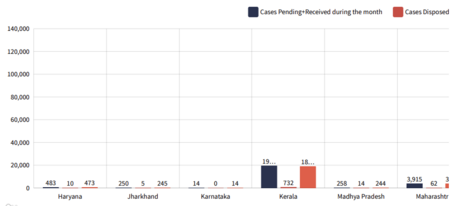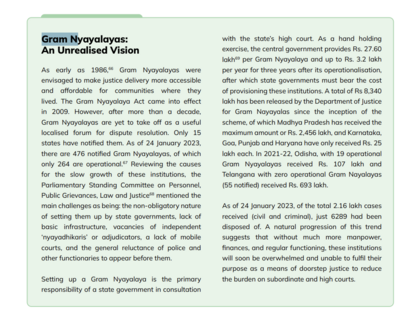Gram nyayalaya
हिंदी में देखने के लिए
What is Gram Nyayalaya
Gram Nyayalaya ("village courts") are rural or village-level courts that were established with a clear objective: to bring justice to the doorsteps of citizens and eliminate barriers to access justice based on social, economic, or other disadvantages[1]. Prior to the Gram Nyayalaya, Gram Kachcheri courts were delivering timely and cheap justice across states such as Bihar[2]. The Law Commission of India, recognizing the need for speedy, substantial, and affordable justice for the common man, recommended the establishment of Gram Nyayalaya in its 114th report of the law Commission of India[3]. Subsequently, the Parliament enacted the Gram Nyayalayas Act, 2008[4], empowering these grassroots-level courts.
These Nyayalayas, with jurisdiction determined by state governments in consultation with respective High Courts[5], play a crucial role in dispensing justice. Nyayadhikaris, appointed under the Act, have the authority to conduct mobile courts and proceedings in villages[6].
Official Definition
According to Section 2(a) of the Gram Nyayalayas Act, 2008, Gram Nyayalayas are defined as a court established under sub-section (1) of section 3.[7]
Establishment
Section 3 of the Gram Nyayalayas Act, 2008, empowers state governments, in consultation with High Courts, to set up Gram Nyayalayas in every intermediate-level Panchayat or a group of adjacent Panchayats within a district or where there is no Panchayat at intermediate level in any State, for a group of contiguous Gram Panchayats. The headquarters are designated in the respective Panchayat or another location notified by the state government.
Composition
Section 5 of the Gram Nyayalayas Act, 2008, mandates the appointment of Nyayadhikari, the presiding officer, by the State Government in consultation with the High Court. Nyayadhikari qualifications align with those of a First Class Judicial Magistrate, with provisions for reservation. The salary matches that of a Judicial Magistrate of the first class (Section 7).
Jurisdiction
Territorial jurisdiction is determined by state governments, allowing Gram Nyayalayas to function as mobile courts. Section 11 of the Gram Nyayalayas Act, 2008, grants jurisdiction over both criminal and civil matters, including pecuniary jurisdiction as per guidelines from the respective High Court. Gram Nyayalayas can adjudicate offences specified in the First Schedule and civil suits outlined in the Second Schedule of the Act[8]. They function in addition to regular civil and criminal courts. Under Section 30 special evidence consideration is permitted
Procedure
The Act incorporates the Code of Criminal Procedure, 1973, for criminal matters, emphasizing a simplified procedure initially (Sections 18 and 19). In civil matters, Nyayalayas deviate from the Code of Civil Procedure, utilizing discretionary powers for faster justice delivery (Section 24(6)).
As per Section 24(8), a Gram Nyayalaya is required to dispose of matters within a period of six months from the date of their institution. This provision emphasizes the need for expeditious resolution of cases, ensuring timely justice delivery in rural areas.
For both criminal and civil matters, appeals against Gram Nyayalaya's decisions can be filed within a six-month limitation period. Criminal appeals go to the Sessions Court, while civil appeals go to the District Court of the concerned jurisdiction.
'Gram Nyayalaya' as Defined in Government Reports
114th Law Commission Report
In its 114th report[9], the Law Commission of India advocated for the establishment of Gram Nyayalayas, aiming to provide prompt, cost-effective, and substantial justice to the common man. The commission suggested introducing Gram Nyayalayas with a dual focus: firstly, to alleviate the backlog of cases at subordinate levels, and secondly, to usher in a participatory approach to justice. Stressing the necessity for a decentralized judicial system, the commission recommended the addition of a new tier, represented by Gram Nyayalayas, at the grassroots level of the judiciary.
Second National Judicial Pay Commission
The report highlights several challenges hindering the effective implementation of Gram Nyayalayas, including the lack of a separate cadre of Nyayadhikaris, the unavailability of regular Judicial Magistrates due to workload, inadequate infrastructure, and insufficient government support. It urges High Courts and State Governments to take immediate steps to address these issues by improving working conditions, providing proper court venues, residential facilities, and vehicles for Nyayadhikaris. The Commission also suggests strengthening the judicial cadre instead of creating an ad hoc system. Additionally, it stresses the importance of Legal Services Authorities coordinating with Gram Nyayadhikaris to support villagers seeking justice[10].
Evaluation Study of the Scheme of Establishing and Operationalizing Gram Nyayalayas, January, 2018
The report[11] 'Evaluation Study of the Scheme of Establishing and Operationalizing Gram Nyayalaya' sponsored by the Ministry of Law & Justice and conducted in January 2018 revealed some concerning statistics. Between 2009-10 and 2017-18, only 320 Gram Nyayalayas were notified by various State Governments, out of which only 204 are currently operational. Only 11 states have taken steps to notify Gram Nyayalayas, which goes against the legislative intent and purpose of the act. The act aims to provide 'justice at the doorstep' for all citizens and ensure 'access to justice' for everyone.
Appearance in Official Databases
Gram Nyayalaya dashboard
The Department of Justice, Ministry of Law and Justice, Government of India[12], offers comprehensive information on Gram Nyayalayas through its website. This resource covers the introduction, features, funds allocation, and performance metrics of these village-level courts in India. The website features a dynamic dashboard presenting various statistics, including the number of notified and operational Gram Nyayalayas in different states. Additionally, it provides insights into the funds sanctioned by the central government for the effective functioning of these legal entities.



India Justice Report
The Indian Justice Report[13] is an annual report that ranks the states and union territories of India based on their performance in four pillars of justice delivery: police, prisons, judiciary, and legal aid. The report identifies various challenges and issues that hinder the functioning and performance of these courts, such as the non-mandatory nature of setting them up, the lack of infrastructure, staff, funds, and mobility, and the low cooperation from the police and other authorities. The report also provides some data and statistics on the number of notified and operational gram nayalayas, the funds allocated and released by the central and state governments, and the cases received and disposed of by these courts.

As per the IJR Report 2022[14], Gram Nayalayas are described as an unrealised vision, due to their slow growth, non-obligatory nature and lack of basic infrastructure.The report suggests that gram nayalayas need more support and resources to fulfil their role as a means of delivering justice at the doorstep and reducing the burden on the higher court.
Research that Engages with Gram Nyayalaya
Foundation of Gram Nyayalayas- Gram Kachcheri's.
Prior to the Gram Nyayalaya Act, 2008, villages in Bihar were operating through Gram Kachcheri's. They were courts that would deliver cheap and timely justice throughout Bihar, usually in matters relating to small disputes such as petty theft and family feuds[15]. The report on Study of the Institution of Gram Kachahari in Bihar by the SIGMA Foundation evaluated the effectiveness of these courts, assessing their accessibility, efficiency, and public satisfaction. Studying 15 Kachaharis across all divisions using surveys and interviews, the study found that 88.6% of 1,059 cases over five years were resolved amicably, with most disposed of within six weeks. These courts offer low-cost, speedy justice for minor civil and criminal matters, though challenges like poor infrastructure, staff shortages, and weak monitoring persist. While most villagers expressed satisfaction, marginal communities showed limited trust[16].
Institutionalizing Justice: Gram Nyayalayas and Consumer Courts
This article highlights two promising measures adopted by the judiciary in the pursuit of access to justice: (a) the gram nyayalayas set up under the Gram Nyayalayas Act, 2008 and (b) the consumer forums established under the Consumer Protection Act, 1986. They also work as good illustrations of the ‘concerted effort' in India to move cases out of the formal courts, with alternate dispute resolution mechanisms assuming increasing significance and taking various forms. The article analyzes how consumer forums have been the focus of evolving reforms for improvement.[17]
Centre for Justice Innovation
In the United States, the Centre for Court Innovation outlines six guiding principles for community courts[18]: restoring the community, bridging the gap between communities and courts, integrating a fragmented criminal justice system, assisting offenders in addressing underlying issues leading to crime, enhancing court information, and constructing a courthouse that mirrors these aspirations. These courts are designed to respond to particular concerns of communities[19]
International Experiences
United States of America
In the United States, community courts[20] have been established on principles akin to India's Gram Nyayalayas, focusing on neighbourhood-centric court programs that synergize the community and the justice system to address local issues. While both these courts aim to provide justice at the grass-root level, they differe in their structures and focus. Community Courts in the United States are typically integrated into the larger judicial system, addressing particular categories of cases, such as drug-related offences or domestic violence, within designated geographic regions. In contrast, Gramme Nyayalayas in India function as mobile, village-level courts possessing both civil and criminal jurisdiction for minor offences and disputes.
Bangladesh
Village courts are a form of local dispute resolution mechanism in Bangladesh, established by the Village Court Act, 2006. They aim to provide accessible, speedy, and low-cost justice to the rural people, especially the poor and vulnerable, for petty civil and criminal cases. Village courts are expected to resolve cases within 30 days, and the decisions are binding and enforceable by law. Village courts have shown positive impacts on the rural justice system in Bangladesh. They have reduced the case backlog and the cost and time of litigation in the formal courts, increased the satisfaction and trust of the people in the justice system, and empowered women and marginalized groups to access justice. Village courts have also contributed to social harmony, peace, and development in rural communities[21].
References
- ↑ see the preamble of the gram nyayalayas act, 2008. it reads thus: “an act to provide for the establishment of gram nyayalayas at the grass roots level for the purposes of providing access to justice to the citizens at their doorsteps and to ensure that opportunities for securing justice are not denied to any citizen by reason of social, economic or other disabilities and for matters connected therewith or incidental thereto.”
- ↑ Gram kachcheri was set up under Section 90 of the Bihar Panchayati Raj Act, 2006. The Bihar panchayat raj act, § 90 (2006).https://www.indiacode.nic.in/bitstream/123456789/11212/1/act_bihar_panchayat_raj_act_2006_-_english.pdf
- ↑ Law commission of India, Gram Nyayalaya (114 1986).
- ↑ Gram nyayalaya act (Ministry of Law and Justice 2008). https://pib.gov.in/newsite/erelcontent.aspx?relid=52951
- ↑ Gram nyayalaya act § 3 (Ministry of Law and Justice 2008).
- ↑ Gram nyayalaya act § 9 (Ministry of Law and Justice 2008).
- ↑ Gram nyayalaya act § 3 (Ministry of Law and Justice 2008).
- ↑ The Gram Nyayalayas Act, 2008, §11.
- ↑ Law Commission of India, Gram Nyayalaya, (114 1986).
- ↑ Report of the Second National Judicial Pay Commission (Vigyan Bhawan Annexe, New Delhi, Feb. 2022), https://cdnbbsr.s3waas.gov.in/s35d6646aad9bcc0be55b2c82f69750387/uploads/2024/10/202410141813954543.pdf
- ↑ Evaluation Study of the Scheme of Establishing and Operationalizing Gram Nyayalayas, .Available at: http://nyay.upsdc.gov.in/MediaGallery/GramNyayalayaEvaluationReport.pdf
- ↑ Gram Nyayalaya, Department of Justice https://dashboard.doj.gov.in/gn/index.php.
- ↑ India Justice Report: Ranking States on Police, Judiciary, Prisons and Legal Aid (2022).
- ↑ Ranking States on Police Judiciary Prisons & Legal Aid, India Justice Report, (100, 2022).
- ↑ Available at https://scroll.in/article/1079886/the-unlikely-success-of-a-novel-justice-delivery-system-in-bihar
- ↑ The study was conducted by SIGMA Foundation with support from Azim Premji University and covered 15 Gram Kachaharis across Bihar six selected for good performance and nine selected randomly, one from each administrative division. The report is available at https://publications.azimpremjiuniversity.edu.in/5681/1/Final%20Report_MN%20Roy.pdf
- ↑ Robert Moog. 2008. ‘The Study of Law and India’s Society: The Galanter Factor’, Law and Contemporary Problems, 71(2): 129–137, p. 129. Also available online at http://scholarship.law.duke.edu/cgi/viewcontent.cgi?article=1470&context=lcp.
- ↑ Available at: https://www.innovatingjustice.org/updates/community-court-research-a-literature-review/
- ↑ id.
- ↑ Bureau of Justice Assistance. (2023). Community Courts Initiative | Overview. [online] Available at: https://bja.ojp.gov/program/community-courts/overview [Accessed 24 Jan. 2024].
- ↑ Southsouth-galaxy.org. (2019). Village Court in Bangladesh: Bridging the Justice Gap | South-South Galaxy. [online] Available at: https://my.southsouth-galaxy.org/en/solutions/detail/village-court-in-bangladesh-bridging-the-justice-gap [Accessed 24 Jan. 2024].
